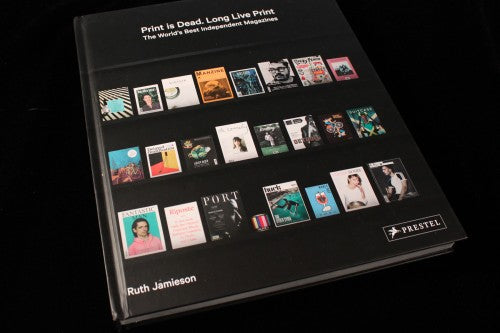
Out now: Print Is Dead. Long Live Print

There is so much interest in independent magazines and the people behind them here in London today that barely a week goes by without another panel discussion or presentation. This is part of a broader trend – the ease of connecting online has encouraged a desire to connect in person with like-minded people across most creative disciplines – and long may it last.

Last week saw the opening of The Ride Journal’s exhibition of their artworks, and the same night there was a small event at Shoreditch House to mark the publication of Ruth Jamieson’s book ‘Print is Dead. Long Live Print’. I’ve mentioned the book in passing here, but it’s worth a longer mention as it represents the maturing of the indie mag into a more generally acknowledged medium. Already this year we’ve seen BBC Newsnight pick up on the story, along with various newspapers.

Ruth’s book is a survey of international independent magazines, showing impeccable taste in its selection and providing valuable background interviews with their makers. Regular magCulture readers probably aren’t going to discover anything new in the book – you’ll already have copies of your favourite featured magazines – but it is an excellent introduction for newcomers, and will be looked back on as an essential record of this era. Magazines come and go, that’s a part of the form’s make up; books like this provide a more permanent record. While not positioned as a how-to guide, anyone thinking of launching a magazine will find plenty to help them here.
Each magazine has its own section, and leads with a photo of the magazines sat on a black background. If you know Berlin’s Do You Read Me? shop you’ll recognise the presentation; the colours of the covers shine out from the dark. In fact the entire content sits on a black background, and its a credit to the printer that this works, although the regular format gives the book a slight cataloguish air (it’s also near impossible to photograph well).
Last week’s panel discussion featured three experienced speakers: Riposte’s Danielle Pender, The Gourmand’s David Lane and Delayed Gratification’s Rob Orchard, together with Ruth as moderator.
The most interesting part of the discussion came towards the end of the session, as the speakers addressed the end of print. Although sharing the problems and financial stress of publishing your own magazine, all three speakers were clear that the end of print applied only to the mainstream. Rob pointed out that without expensive central London HQs and large staffs, small mags could survive on around 10k sales, suggesting a middle tier between indie and mainstream is emerging at that level. He also made the point that the distinction between small and large, indie and mainstream is fading as indies sell more and big titles sell less.
David built on this, reminding us that ‘it’s the traditional model that is dead’. He championed the indies with their multiple business models, asking ‘why do brands still buy traditional print ads?’ as he and Danielle both discussed working with the savvier brands to create bespoke promotions in their mags.
The last word comes from author of the book Ruth, who summerised with ‘the mainstream mags that survive will be the ones that learn from indies.’ This is already starting to happen– for example, the recently announced reinvention of US Condé Nast Traveler as a ‘luxury’ item with better paper and print in a larger page size..
randomhouse.de/book/Print-is-Dead-Long-live-Print


